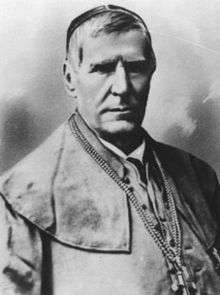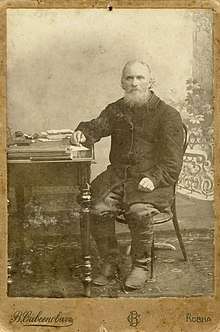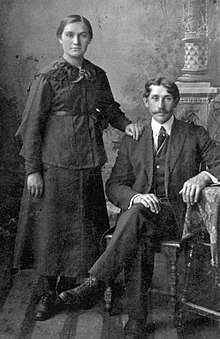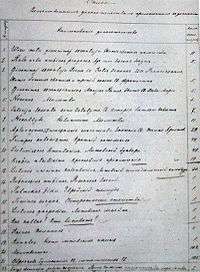Lithuanian book smugglers
Lithuanian book smugglers or Lithuanian book carriers (Lithuanian: knygnešys, plural: knygnešiaĩ) transported Lithuanian language books printed in the Latin alphabet into Lithuanian-speaking areas of the Russian Empire, defying a ban on such materials in force from 1864 to 1904. In Lithuanians it literally means the one who carries the books. Opposing imperial Russian authorities' efforts to replace the traditional Latin orthography with Cyrillic, and transporting printed matter from as far away as the United States to do so, the book smugglers became a symbol of Lithuanians' resistance to Russification.


History

After the Polish-Lithuanian insurrection I of 1863, the Russian Imperial government intensified its efforts to Russify the Lithuanian population and alienate it from its historic roots, including the Roman Catholic faith, which had become widespread during the years of the Polish-Lithuanian Commonwealth.

.jpg)
During the summer of 1863 Tsar Alexander II issued Temporary Rules for State Junior Schools of the Northwestern Krai, ruling that only Russian-language education would be allowed there. In 1864, the Governor General of the Vilnius Governorate, Mikhail Muravyov, ordered that Lithuanian language primers were to be printed only in the Cyrillic alphabet. Muravyov's successor, Konstantin Kaufman, in 1865 banned all Lithuanian-language use of the Latin alphabet. In 1866, the Tsar issued an oral ban on the printing or importing of printed matter in Lithuanian. Although formally, the order had no legal force, it was executed de facto until 1904. During this time, there were approximately fifty-five printings of Lithuanian books in Cyrillic.
Most of the Latin-alphabet Lithuanian-language books and periodicals published at the time were printed in Lithuania Minor and then smuggled into Lithuania. When caught, the book smugglers were punished by fines, banishment, and exile, including deportation to Siberia. Some were simply shot in the head while crossing the border or executed on the spot.
In 1867, Motiejus Valančius, the Bishop of Žemaitija, began to covertly organize and finance this printing abroad and sponsored the distribution of Lithuanian-language books within Lithuania.[1] In 1870, his organization was uncovered with the help of Prussian authorities, and five priests and two book smugglers were exiled to remote areas of Russia. Other book smugglers carried on his work.
During the final years of the ban, an estimated 30,000 to 40,000 books were smuggled in annually. About one-third of them were seized by authorities. Lithuanian books reached every settlement in Lithuania, and many legal institutions served as undercover transfer points for the books. A number of secret organizations distributed the books throughout Lithuania, including Sietynas, Atgaja, Teisybė, Prievarta, Aušrinė, Atžala, Lizdas, Akstinas, Spindulys, Svirplys, Žiburėlis, Žvaigždė, and Kūdikis.
In East Prussia since 1864 up to 1896, more than 3 500 000 copies of publications in Lithuanian language was published: about 500 000 primers, more than 300 000 scientific secular editions, 75 000 newspapers and other types of publications.[2]
The ban's lack of success was recognized by the end of the 19th century, and in 1904, under the official pretext that the minorities within the Russian Empire needed to be pacified after the failure in the Russo-Japanese War, the ban on Lithuanian-language publications was lifted.
In 1905, soon after the ban was lifted, one of the book smugglers, Juozas Masiulis, opened his own bookstore in Panevėžys. This bookstore is still operational, and a chain of bookstores operates in Lithuania under his name.[3]
This historical episode was widely suppressed during the years when Lithuania was occupied by the Soviet Union.
Book smuggler societies
.jpg)
| Society | Location | Years active | Members[4] |
|---|---|---|---|
| Of Motiejus Valančius | Kovno Governorate | 1867–70 | ? |
| Of Martynas Sederavičius | Sudargas; active in Samogitia and Suvalkija | Early 1870s – beg. of the 20th century | ? |
| Of Garšviai | Garšviai; active in Panevėžys and Ukmergė regions | 1883–95 | 5–7 |
| Atgaja (Refresh) | Šiauliai region | 1889–95 | 3–11 |
| Šviesa Bookstore (Light ) | Jurgežeris, Kalvarija District | 1880 | ? |
| Rural Society of Plowmen | Šiauliai region | 1891 | ? |
| (no name) | Panevėžys region | 1892 | 9 |
| (no name youth) | Panemunė volost, Marijampolė | 1892 | ? |
| Nemunėlis and Apasčia | Biržai region | 1893–? | 7–? |
| Teisybė (Truth) | 1893 – after 1896 | 5–15 | |
| Aušrinė | Kovno Governorate | 1893–94 | 7 |
| Prievarta (Coersion) | 1894 | ? | |
| Darželis (Little Garden) | Krikliniai | 1894–95 | 16 |
| Atžala (Offshoot) | Grinkiškis | 1894 | 6–10 |
| Sietynas (Pleiades) | Marijampolė district | 1894–97 | 70 |
| Žiburėlis (Little Beacon) | Panevėžys region? | 1897 | 5–15 |
| (no name) | Marijampolė district | 1898 | 15 |
| (no name) | Kovno Governorate | 1899 | 27 |
| Žvaigždė (Star) | Panemunėlis | 1900–02 | 20 |
| Lithuanian Youth | Raseiniai region | 1900–01 | 15 |
| Spindulys (Ray) | Marijampolė district | 1900 | ? |
| Artojai (Plowmen) | Marijampolė | 1901–05 | 13–48 |
| Aušrelė (Little Dawn) | Panemunėlis | 1900–03 | 5–15 |
| Union of Lithuanian Farmers | Aukštaitija | 1901 | 13–20 |
| (no name) | Kovno Governorate | 1902 | ? |
| Mužikėlis (Peasant) | Kairiai | 1903 | ? |
| Vienybė (Unity) | Kairiai | 1903–05 | 5–7 |
Remembrance

The book smugglers were an important part of the Lithuanian National Revival. After the dissolution of the Soviet Union, book smugglers were honored in Lithuania with museums, monuments, and street names. A statue dedicated to "The Unknown Book Smuggler" stands in Kaunas. Special relationship of Lithuanians and the book is still seen in the highly popular Vilnius Book Fair.
Book smuggler Jurgis Bielinis, who created a secret distribution network for banned Lithuanian books, was born on 16 March 1846, and this date is commemorated in Lithuania as the Day of the Book Smugglers (Knygnešio diena).
In 1988, the Lithuanian Knygnešiai Association was established at the Lithuanian Culture Foundation. Among its goals was to collect information about all Lithuanian book smugglers and printers. As of 2017, four volumes titled Knygnešys were printed. In 1997, the "Book Smugglers' Wall" was unveiled at the Vytautas the Great War Museum. and in 1998 a book Šimtas knygnešių. Knygnešių sienelės vardai ("One Hundred Books Smugglers. Names on the Book Smugglers' Wall") was published.[5]
During 1959–2000 there was a magazine named Knygnešys which provided information about (modern) books and book publishers.
In 2018 London Book Fair the tactics of Knygnešiai was used to distribute books of the Lithuanian authors and spread the information about the Lithuanian pavilion.[6]
See also
Bibliography
- Ruseckas, Petras (1992–1997) Knygnešys : 1864–1904 (Book-smuggler: 1864–1904) (3 vols.) Valstybinis leidybos centras, Vilnius, ISBN 9986-810-06-X (Volumes 1 & 2, reprint, originally published: Spaudos fondas, Kaunas, 1926–1928) (in Lithuanian);
- Merkys, Vytautas (1994) Knygnešių laikai: 1864–1904 (The era of the book-smugglers: 1864–1904) Valstybinis leidybos centras, Vilnius, ISBN 9986-09-018-0 (in Lithuanian);
- Merkys, Vytautas (1994) Draudžiamosios lietuviškos spaudos kelias: 1864–1904: informacinė knyga (The path of the banned Lithuanian press: 1864–1904: An information book) Vilnius: Mokslo ir enciklopedijų leidykla, Vilnius, ISBN 5-420-01181-6 (in Lithuanian);
- Kaluškevičius, Benjaminas and Žemaitytė-Narkevičienė, Ona (1998) Šimtas knygnešių: knygnešių sienelės vardai (One Hundred Book Carriers: The Names on the Book Carriers Wall) Lietuvos kultūros fondas, Lietuvos Knygnešio draugija, Vilnius, ISBN 9986-9175-0-6 (in Lithuanian);
References
- Waters, Michael. "The 19th-Century Lithuanians Who Smuggled Books to Save Their Language". atlasobscura.com. Retrieved 16 March 2019.
- Bružas, Rimas (2013). Tauta be valstybės. Valstybės kelias. Vilnius: Vaga. p. 79. ISBN 978-5-415-02287-8.
- Čiplytės, Joana Vigos (2005) Juozas Masiulis: knygnešys ir knygininkas Žara, Vilnius, ISBN 9986-34-140-X (in Lithuanian)
- Merkys, Vytautas (2016). "Knygnešių organizacijos". In Manelis, Eugenijus; Račis, Antanas (eds.). Lietuvos istorija. Enciklopedinis žinynas (in Lithuanian). II. Mokslo ir enciklopedijų leidybos centras. p. 859. ISBN 978-5-420-01765-4.
- "Apie knygnešius" Archived 2017-12-23 at the Wayback Machine, by Sigitas Birgelis (retrieved December 22, 2017)
- "Lithuania's 'Day of the Book Smugglers' Comes to the UK Ahead of London Book Fair". publishingperspectives.com. Retrieved 31 May 2018.
External links
- Statue entitled Knygnešys by Juozas Zikaras in Kaunas.
- Booksmugglers
- Knygnešiai / Smugléirí Leabhar a 2010 Lithuanian-Irish historical documentary.
- Knygnešys a 2011 feature film created by director Jonas Trukanas.